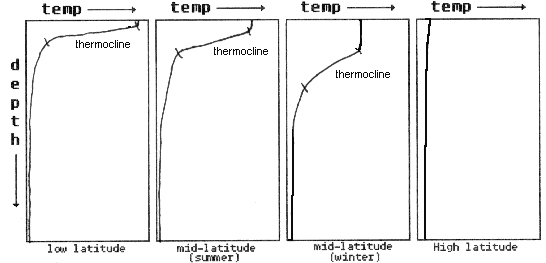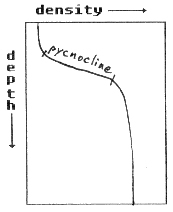1. No, the center of positive charge would be in the same place as the center of negative charge.
2. Polar means that the water molecule has positive and negative ends. The positive end of one water molecule is attracted to the negative end of another water molecule - that makes a hydrogen bond.
3. When liquid water is heated, only part of the heat energy is used in making water molecules move faster. The rest is converted into electrical potential energy as hydrogen bonds break. Thus, a given addition of heat produces a relatively small rise in temperature, which is the same a saying that water has a high heat capacity.
4. 35 + 80 = 115 calories
5. Water’s latent heat of evaporation at 20oC is higher (585 cal) than it’s latent heat of vaporization (540 cal). The 45-calorie difference reflects the greater number of hydrogen bonds that must be broken for water to evaporate at 20oC.
6. Sketch the graphs of water density vs. temperature, salinity, and pressure below.

7. The pressure increases 1 atm. for every 10 meter increase in depth, so the increase in pressure from the surface to 11,000 meters would be 1,100 atm. Add to this the pressure at sea level (1 atm) gives a total pressure of 1,101 atm at 11,000 meters.
8. Temperature
9. The density of the ocean's surface water would increase from the equator to the poles.
10. Plot the graph of temperature vs. depth at different latitudes and for different seasons, and show the location of the thermocline (if present).

11. Sketch the graph of seawater density vs. depth at an equatorial latitude (warm, low salinity surface waters) below and indicate the position of the pycnocline:

12. Small particle size favors absorption over scattering, while the situation Is reversed for large particles. Long light wavelengths are more readily absorbed than scattered, and again the reverse is true for short wavelengths. So, small particles and long wavelengths is the ideal situation for absorption, and large particles and short wavelengths lend themselves to scattering.
13. Clear seawater is composed primarily of small water molecules which tend to absorb the longer wavelengths and only scatter very short wavelengths. In the visible light spectrum, the most prevalent short waves are blue. Since the blue light is scattered back to our eyes while the longer wavelengths are absorbed, we see the ocean as blue. When sediments are suspended in turbid water, the absorption/ scattering relationship is altered. The larger sediment particles are more efficient scatterers than water molecules, so longer wavelengths are affected. This means our eyes see more of the green and yellow waves. So turbid water appears more greenish.
14. As our stylish diver descended into the gloom, her designer wetsuit would become progressively less vibrant. From long wavelength to short, one after one, the colors would fade to gray and then to black as the water absorbed their part of the light spectrum First, the reds would disappear, then the oranges and yellows until all the color was gone and she was left cloaked in an almost indiscernible black.
15. Use the principle of light refraction to estimate the apparent location of the fish as seen by the goon.

16. The depth where the speed of sound reaches its minimum in the ocean varies with conditions but averages 1200 meters in the North Atlantic and 600 meters in the North Pacific. sound transmission in this layer is generally very efficient because sound waves tend to refract off the faster layers above and below and remain channeled in the so called Sofar layer. Sound in the Sofar layer travels slowly, but does not dissipate nearly as rapidly as it does in the faster zones. Consequently, sound - especially low frequency sound - can travel great distances in the Sofar. In a navy test, sounds generated in this layer were detected over 11,000 miles away! Whales also are thought to send low frequency messages for very long distances and probably discovered the Sofar channel before man.
17. If the speed of sound varies as shown, where should a submarine be to evade detection by the ship's SONAR? Also show the position of the SOFAR channel.


8800 Grossmont College Drive
El Cajon, California 92020
619-644-7000
Accessibility
Social Media Accounts